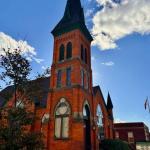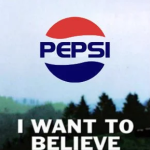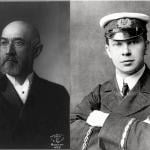Glimpsing the man behind the mural
Some days he looks weary. Occasionally it seems he might be the tiniest bit angry.
But most of the time, the man in the mural with the piercing yellow-hazel eyes who stares across the trashy vacant lot at the corner of Lake and Damen looks like he’s got something to say.
Something wise.
His disembodied head floats there on the side of a building like a modern Wizard of Oz. Like an urban oracle.
At least a couple of times a week since the mural appeared in summer 2001, I’ve forsaken the Eisenhower and taken the scenic route to work, heading east on Lake Street through the West Side, hoping that the light at Damen would be red so I could stare at “the 50/50 guy.”
I call him that because painted alongside his face is, inexplicably, the red-white-and-green logo from a 50/50-brand soft drink.
For the longest time I couldn’t decide if the mural was a work of art or a high-concept ad for lemon-lime soda. Either way, I wondered if the man with those haunting eyes was a real person.
Was he a figure from African-American history I should recognize but don’t? A neighborhood hero martyred in street violence?
Maybe it was a self-portrait of the muralist, or simply a character from his imagination.
On Monday, in a fit of this-is-the-day-I-must-know-and-by-God-I-shall-induced curiosity, I learned the truth.
Actually, I met the truth.
His name is Oba Maja. He’s a street poet in Wicker Park.
Oba Maja stands next to Jeff Zimmermann’s mural of him at Damen and Lake in Chicago. (Chicago Sun-Times photo by Dom Najolia)
And yes, his eyes really are that color.
Oba, 61, is the father of 12, grandfather of 22 — at least that’s his best guess — and a graduate of St. Patrick High School. He changed his name from Wayne to Oba (which means “possessed by the spirit of the king,” he said) during the black power movement of the 1960s.
Jeff Zimmermann, the Chicago artist who painted the mural called “Top of the World,” on the southern wall of 215 N. Damen, told me where I could find Oba.
He usually hangs out near a quickie mart on Milwaukee next to the entrance to the Flat Iron Building, Zimmermann said. That’s exactly where I found him around noon, standing on the sidewalk with a tall cup of coffee in his hand.
Were it not for the dark sunglasses he was wearing, I wouldn’t have needed to ask if he was the 50/50 man.
“Are you Oba?” I said.
“Yes, ma’am, I am,” he said, removing his sunglasses and his gloves to shake my hand.
There they were. Those eyes, those magical eyes. I felt like I was meeting a movie star. Or Harry Potter.
A tear was running down his thin, left cheek, the product, I assumed, of the cold wind. So we went inside a nearby cafe, where the staff greeted him by name, and settled into a table in the back where he told me the story of the mural.
Oba isn’t homeless. He wants people to know that. He has a nice place on North Avenue near Laramie with a color TV. He pays $45 a week in rent.
But he does make his living on the street, selling poems to passersby. Sometimes he recites them. Other times he sells photocopies of his handwritten work.
That’s how he met Zimmermann several years ago. “I’d always see Jeff and he’d never buy one of my poems,” Oba said, adding that he’s sold his poems for as little as a dime and as much as $375. “He said, ‘I’m not gonna buy one of your poems, but I am gonna make you famous.’ And he did.”
Zimmermann tells the same story. The artist has painted several murals around the city, always featuring real people as characters. He met Oba and liked his face — “a real character,” is how he describes it — took a few snapshots, and the poet wound up as the centerpiece of the mural.
Standing in the alley that runs in front of the mural, which also features a smaller portrait of an African girl and a giant crumpled Fritos bag with the silver lining showing (Zimmermann calls them “urban tumbleweeds”), Oba looked up at his face and smiled. “Yeah, Jeff did a great job,” he said.
Directly across Lake Street is a public housing complex that has seen better days. It’s what Oba’s face stares at day and night.
The poet said he’d like to think he inspires the people who live there.
“I’m offering hope,” Oba said sweetly. “I’m offering beautiful thoughts. . . . I make people realize the value and the beauty of watching a sunset, the beauty inside themselves.
“I wrote a poem called ‘The Cosmic Twins.’ I say, well, you have the eye and then you have the ‘I,’ the person. And sometimes you put too much emphasis on the ‘I,’ the self, by always looking into the mirror of ourselves. And we don’t notice the beauty around us, the people. Nature.
“Sometimes we need to pay attention to both ‘I/eyes.”
If I were ever to leave Chicago there are three things I’d want to take with me that wouldn’t fit in any moving van: Terri Hemmert’s voice on the radio, the aroma of Blommer’s Chocolate Factory on a hot August afternoon, and the mural with Oba’s face.
I told the poet as much. He thanked me for the compliment and offered something I could take with me by reciting his poem of the day.
It was a simple, if awkward, meditation on materialism that ended with the phrase, “Tomorrow is not promised to nobody.”
He called it, “Twilight at the Crossroads.”
Copyright © The Sun-Times Company
All rights reserved. This material may not be published, broadcast, rewritten, or redistributed.















